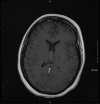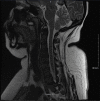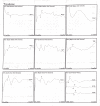Paradoxical Hyperreflexia in a Patient With Classic Guillain-Barré Syndrome
- PMID: 38186504
- PMCID: PMC10771819
- DOI: 10.7759/cureus.50184
Paradoxical Hyperreflexia in a Patient With Classic Guillain-Barré Syndrome
Abstract
Background: Guillain-Barré syndrome (GBS) is a rare entity with characteristic features, including progressive ascending paralysis. Patients typically present with progressive symmetrical weakness with areflexia in bilateral lower extremities, which can be confounded by psychiatric comorbidities. This case is unusual in that the patient had paradoxical hyperreflexia and normal CSF protein levels during her initial presentation, later confirmed to be GBS.
Case presentation: Here, we describe the case of a young female with bipolar disorder who presented to the hospital with complaints of week-long bilateral lower leg weakness that started abruptly about a month after an episode of multiple stools of bloody diarrhea. The initial neurological exam revealed 4/5 bilateral lower extremity strength and near global areflexia, excluding a 3+ right patellar reflex, and CSF studies returned normal CSF protein levels. Based on the clinical presentation of worsening ascending paralysis, electromyography (EMG) findings, and nerve conduction studies (NCS) consistent with an axonal and demyelinating neuropathy, we diagnosed her with the classic form of Guillain-Barré syndrome with paradoxical hyperreflexia. Imaging results, laboratory findings, treatment decisions, and outcomes of this case are presented.
Keywords: clinical electro-diagnostics; guillain-barre syndrome (gbs); guillian-barre syndrome; lumbar puncture (lp); nerve conduction studies (ncs).
Copyright © 2023, Nguyen et al.
Conflict of interest statement
The authors have declared that no competing interests exist.
Figures





Similar articles
-
Bilateral Facial Palsy and Hyperreflexia as the Main Clinical Presentation in Guillain-Barré Syndrome.Am J Case Rep. 2021 Oct 1;22:e932757. doi: 10.12659/AJCR.932757. Am J Case Rep. 2021. PMID: 34597290 Free PMC article.
-
Pharyngeal-Cervical-Brachial Variant of Guillain-Barré Syndrome.Cureus. 2021 Oct 14;13(10):e18788. doi: 10.7759/cureus.18788. eCollection 2021 Oct. Cureus. 2021. PMID: 34804654 Free PMC article.
-
Reversible conduction failure on the deep tendon reflex response recording in early Guillain-Barré syndrome.Clin Neurophysiol Pract. 2018 Nov 3;3:159-163. doi: 10.1016/j.cnp.2018.09.001. eCollection 2018. Clin Neurophysiol Pract. 2018. PMID: 30560219 Free PMC article.
-
Guillain-Barré syndrome with associated unilateral ptosis without ophthalmoplegia - a rare presentation: a case report and review of the literature.J Med Case Rep. 2019 Jul 20;13(1):221. doi: 10.1186/s13256-019-2157-x. J Med Case Rep. 2019. PMID: 31324211 Free PMC article. Review.
-
Hydrocephalus in Guillain barre syndrome: A case report and review of the literature.Medicine (Baltimore). 2020 Apr;99(16):e18638. doi: 10.1097/MD.0000000000018638. Medicine (Baltimore). 2020. PMID: 32311917 Free PMC article. Review.
References
Publication types
LinkOut - more resources
Full Text Sources
